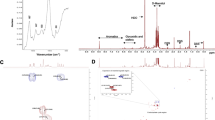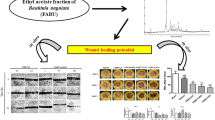Abstract
Objective
To find an inhibitor of 15-hydroxyprostaglandin dehydrogenase (15-PGDH) that rapidly metabolises Prostaglandin E2 (PGE2) as a mediator of wound healing, we examined seven flavonoids for this role.
Results
7,3′,4′-Trimethoxyflavone (TMF) had the lowest IC50 value of 0.34 µM for 15-PGDH inhibition but >400 µM for cytotoxicity, indicating a high therapeutic index. TMF elevated PGE2 levels in a concentration-dependent manner in both A549 lung cancer and HaCaT cells. It also significantly increased mRNA expression of multidrug resistance-associated protein 4 (MRP4) and of prostaglandin transporter (PGT) slightly in HaCaT cells. In addition, TMF facilitated in vitro wound healing in a HaCaT scratch model, which was completely inhibited by adding both 15-PGDH and NAD+ as cofactor, confirming the involvement of PGE2 in its wound healing effect.
Conclusion
TMF with a high therapeutic index can facilitate wound healing through PGE2 elevation by 15-PGDH inhibition.




Similar content being viewed by others
References
Agins AP, Delhagen JE (1987) Metabolism of prostaglandin E2 by human HL-60 leukemia cells. Agents Action 21:400–402
Cho H, Tai HH (2002) Inhibition of NAD+-dependent 15-hydroxyprostaglandin dehydrogenase (15-PGDH) by cyclooxygenase inhibitors and chemopreventive agents. Prostagland Leukot Essent Fat Acids 67:461–465
Cho H, Hamza A, Zhan CG, Tai HH (2005) Key NAD+ -binding residues in human 15-hydroxyprostaglandin dehydrogenase. Arch Biochem Biophys 433:447–453
Ensor CM, Yang JY, Okita RT, Tai HH (1990) Cloning and sequence analysis of the cDNA for human placental NAD(+)-dependent 15-hydroxyprostaglandin dehydrogenase. J Biol Chem 265:14888–14891
Jeong JM, Choi CH, Kang SK, Lee IH, Lee JY, Jung H (2007) Antioxidant and chemosensitizing effects of flavonoids with hydroxy and/or methoxy groups and structure-activity relationship. J Pharm Pharm Sci 10:537–546
Ji XL, Jiang YX, Ren BB, Liu K, Liu G (2007) Effect of bismuth glycyrrhizate on experimental gastric ulcers and its mechanisms. Zhongguo Zhong Yao Za Zhi 32:1429–1432
Kinoshita M, Iwasaki H, Yasoshima A, Tamaki H (1993) Effects of ecabet sodium (TA-2711), a new antiulcer agent, on gastrointestinal mucosal prostanoid production and morphology in rats. Biol Pharm Bull 16:1220–1225
Kleine A, Kluge S, Peskar BM (1993) Stimulation of prostaglandin biosynthesis mediates gastroprotective effect of rebamipide in rats. Dig Dis Sci 38:1441–1449
Koivisto L, Jiang G, Hakkinen L, Chan B, Larjava H (2006) HaCaT keratinocyte migration is dependent on epidermal growth factor receptor signaling and glycogen synthase kinase-3alpha. Exp Cell Res 312:2791–2805
Lacroix-Pepin N, Danyod G, Krishnaswamy N et al (2011) The multidrug resistance-associated protein 4 (MRP4) appears as a functional carrier of prostaglandins regulated by oxytocin in the bovine endometrium. Endocrinology 152:4993–5004
Lin ZP, Zhu YL, Johnson DR et al (2008) Disruption of cAMP and prostaglandin E2 transport by multidrug resistance protein 4 deficiency alters cAMP-mediated signaling and nociceptive response. Mol Pharmacol 73:243–251
Lu R, Kanai N, Bao Y, Schuster VL (1996) Cloning, in vitro expression, and tissue distribution of a human prostaglandin transporter cDNA(hPGT). J Clin Investig 98:1142–1149
Maeng HJ, Lee WJ, Jin QR, Chang JE, Shim WS (2014) Upregulation of COX-2 in the lung cancer promotes overexpression of multidrug resistance protein 4 (MRP4) via PGE2-dependent pathway. Eur J Pharm Sci 62:189–196
Martin P (1997) Wound healing–aiming for perfect skin regeneration. Science 276:75–81
McGreevy JM, Moody FG (1980) A mechanism for prostaglandin cytoprotection. Br J Surg 67:873–876
Mosmann T (1983) Rapid colorimetric assay for cellular growth and survival: application to proliferation and cytotoxicity assays. J Immunol Methods 65:55–63
Muramatsu M, Tanaka M, Suwa T, Fujita A, Otomo S, Aihara H (1984) Effect of 2’-carboxymethoxy-4,4’-bis(3-methyl-2-butenyloxy)chalcone (SU-88) on prostaglandin metabolism in hog gastric mucosa. Biochem Pharmacol 33:2629–2633
Nijveldt RJ, van Nood E, van Hoorn DE, Boelens PG, van Norren K, van Leeuwen PA (2001) Flavonoids: a review of probable mechanisms of action and potential applications. Am J Clin Nutr 74:418–425
Nosalova V, Machova J, Babulova A (1993) Protective action of vinpocetine against experimentally induced gastric damage in rats. Arzneimittelforschung 43:981–985
O’Brien PE, Frydman G, Holmes R, Malcontenti C, Phelan D (1990) Evaluation of putative cytoprotective properties of antiulcer drugs using quantitative histological techniques. Dig Dis Sci 35:1130–1139
Parekh A, Sandulache VC, Singh T et al (2009) Prostaglandin E2 differentially regulates contraction and structural reorganization of anchored collagen gels by human adult and fetal dermal fibroblasts. Wound Repair Regen 17:88–98
Reno F, Grazianetti P, Cannas M (2001) Effects of mechanical compression on hypertrophic scars: prostaglandin E2 release. Burns 27:215–218
Sandulache VC, Parekh A, Li-Korotky H, Dohar JE, Hebda PA (2007) Prostaglandin E2 inhibition of keloid fibroblast migration, contraction, and transforming growth factor (TGF)-beta1-induced collagen synthesis. Wound Repair Regen 15:122–133
Su WH, Cheng MH, Lee WL et al (2010) Nonsteroidal anti-inflammatory drugs for wounds: pain relief or excessive scar formation? Mediat Inflamm 2010:413238
Szelenyi I, Lanz R (1986) Release of cytoprotective PGE2 from cultured macrophages induced by antacids and sucralfate. Agents Actions 18:375–380
Tai HH, Ensor CM, Tong M, Zhou H, Yan F (2002) Prostaglandin catabolizing enzymes. Prostaglandins Other Lipid Mediat 68–69:483–493
Werner S, Grose R (2003) Regulation of wound healing by growth factors and cytokines. Physiol Rev 83:835–870
Yeh FL, Shen HD, Lin MW, Chang CY, Tai HY, Huang MH (2006) Keloid-derived fibroblasts have a diminished capacity to produce prostaglandin E2. Burns 32:299–304
Zhou H, Felsen D, Sandulache VC, Amin MR, Kraus DH, Branski RC (2011) Prostaglandin (PG)E2 exhibits antifibrotic activity in vocal fold fibroblasts. Laryngoscope 121:1261–1265
Acknowledgements
This study was supported by research fund from Chosun University in 2016.
Author information
Authors and Affiliations
Corresponding author
Rights and permissions
About this article
Cite this article
Sun, K.H., Karna, S., Moon, YS. et al. The wound-healing effect of 7,3′,4′-trimethoxyflavone through increased levels of prostaglandin E2 by 15-hydroxyprostaglandin dehydrogenase inhibition. Biotechnol Lett 39, 1575–1582 (2017). https://doi.org/10.1007/s10529-017-2386-2
Received:
Accepted:
Published:
Issue Date:
DOI: https://doi.org/10.1007/s10529-017-2386-2




